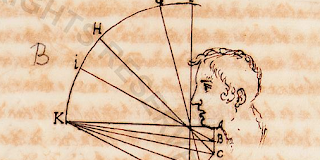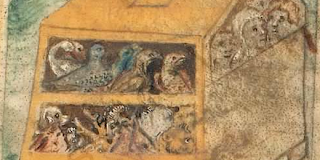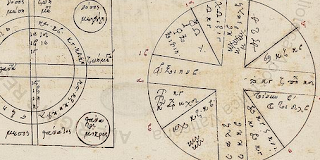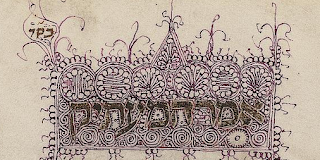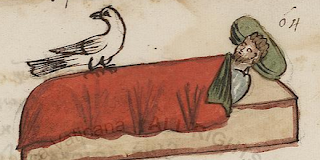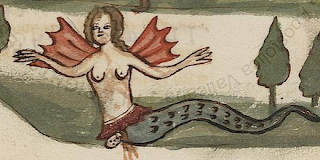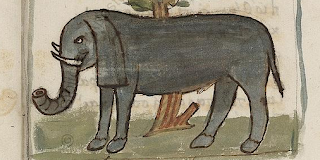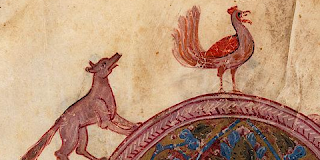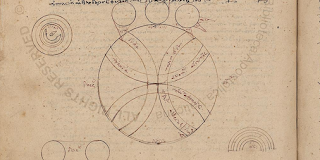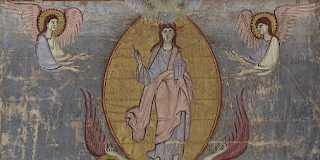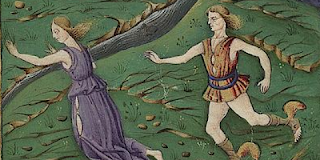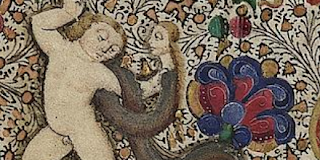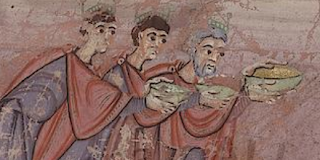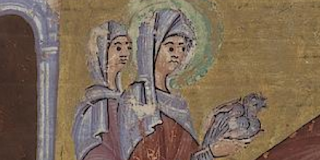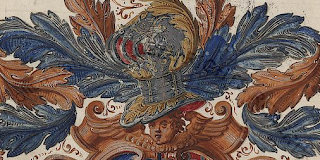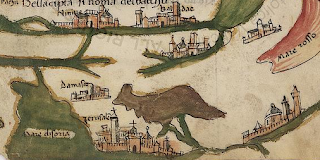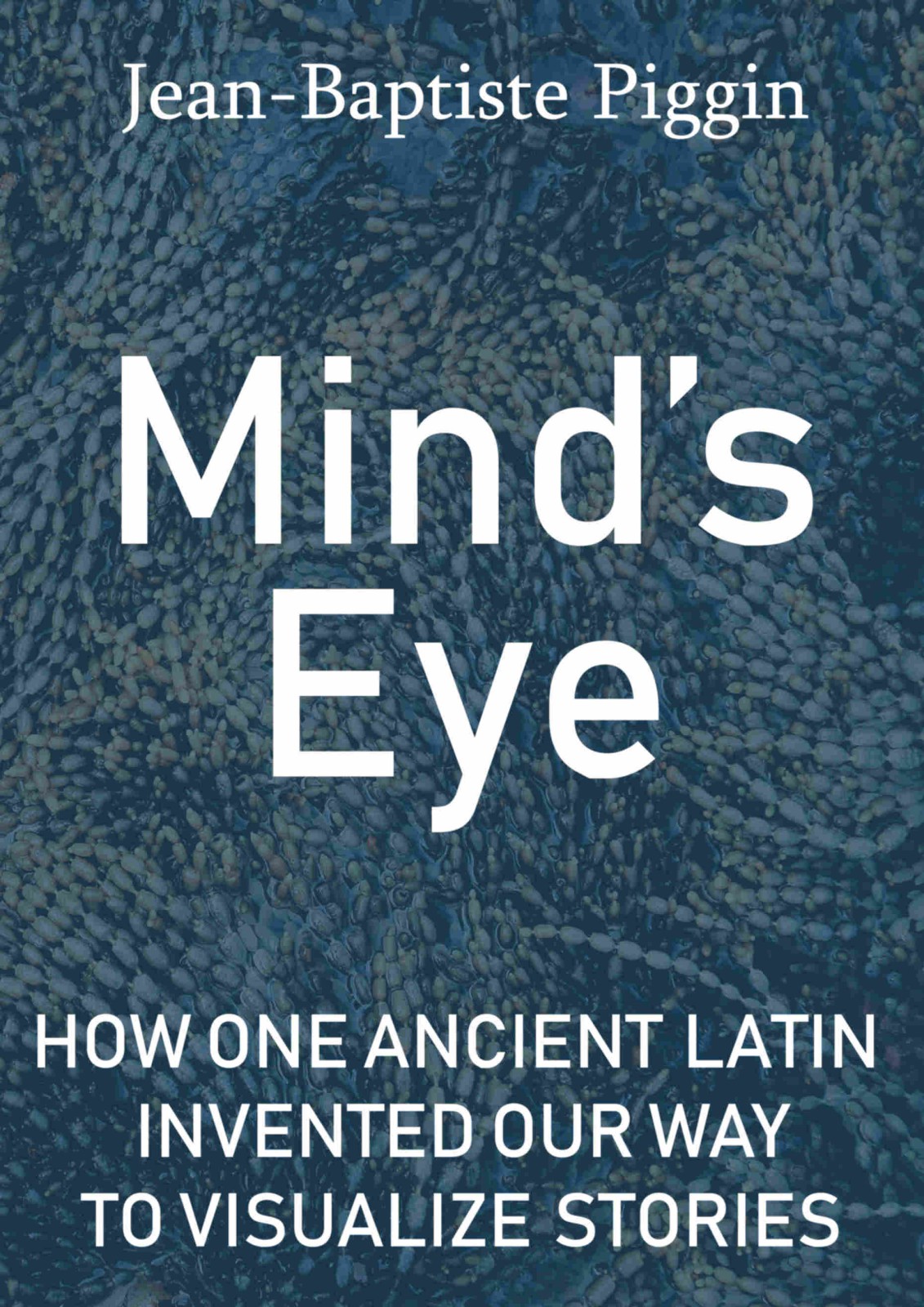Full background on the work and a comparison of the manuscripts can be found on the Treatise on Painting website at the Institute for Advanced Technology in the Humanities, University of Virginia.
Digita Vaticana has been fairly busy as the Roman summer hots up, issuing a total of 204 items on July 14 and 23. Because of my own holiday in Sweden (more from that later), I am getting in arrears, so I beg pardon that the following list is not fully annotated. There are lots of art gems in this release. Here is a nativity scene from the beautiful Barberini Book of Hours:
Below is the full list of 204 items issued on July 14 and 23. The Digita Vaticana index and catalog server is now frequently out of service (more than 80 hours offline July 23-26), so in the following list, most of the links are to the digitizations themselves, where the servers tend to be more stable.
- Arch.Cap.S.Pietro.D.213,
- Arch.Cap.S.Pietro.E.5,
- Arch.Cap.S.Pietro.E.19,
- Arch.Cap.S.Pietro.F.22,
- Arch.Cap.S.Pietro.F.45,
- Arch.Cap.S.Pietro.H.45,
- Barb.gr.10, Donatus Aelius, Ars Grammatica Minor: Pinakes
- Barb.gr.93, Homer's Odyssey (excerpts)
- Barb.gr.102, Manuel Moschopulus: Schedographia: Pinakes
- Barb.gr.176, Phrantzēs, Geōrgios, 1401-1477, Chronicon minus
- Barb.gr.184, Nicephorus Gregoras, 1295-1359/1360, Byzantina historia
- Barb.gr.192, Miscellanea de historia Byzantina
- Barb.gr.206, Poussines, Pierre, 1609-1686, Commentarii in Pachymerae Andronicum
- Barb.gr.212, Hippiatricorum corpus
- Barb.gr.269, Asclepius Trallianus (6th century):In Aristotelis Metaphysicorum libros
- Barb.gr.276, Emperor Maurice, Strategikon, and part of the Cesti of Julius Africanus; this is a section of a manuscript of which the other part is in Paris, BNF, gr. 2442
- Barb.lat.168, Livy's Roman history Ab Urbe Condita, from the famed Corvinius Library of Hungary, illuminated initials
- Barb.lat.370, Nicholas Trivet (Trevet), English writer and chronicler (c.1257 – c.1334),
In Psalterium - Barb.lat.443, incl. Francois de Meyronnes, Passus super universalia (Glorieux)
- Barb.lat.487, Barberini Book of Hours (use of Rouen): the reconstitution of another Rouen book of hours was a hot topic on the blogosphere this week with Lisa Fagin Davis. Read this online and savour the saving of 968 euros.
- Barb.lat.3942, Ariosto's Orlando Furioso
- Barb.lat.3984, Book of Virtues and Vices, illumination (examples below) by the Italian painter Master of the Dominican Effigies
- Barb.lat.4086,
- Barb.lat.4304,
- Barb.lat.4357, 1542 Venetian atlas of portolan maps which belonged to Henry VIII of England (articles by Francesco Solinas and Peter Soustal ... and they are legible!
- Barb.lat.5379, Confession of Pope Alexander VIII, purchaser of Queen Christina's library
- Barb.or.18,
- Barb.or.46 ,
- Barb.or.155, Hebrew alphabet, Arabic astronomy and astrology, in mixed manuscript
- Borg.cin.536,
- Borg.ebr.9, Isaac b. Jacob Alfasi's Code with glosses
- Borg.ill.12,
- Borgh.206,
- Borgh.220,
- Cappon.127,
- Cappon.163,
- Cappon.172,
- Cappon.176,
- Cappon.181,
- Cappon.186,
- Cappon.193,
- Cappon.195,
- Cappon.197,
- Cappon.200,
- Cappon.204,
- Cappon.207,
- Cappon.209,
- Cappon.210,
- Cappon.218,
- Cappon.219,
- Cappon.220,
- Cappon.221,
- Cappon.225,
- Cappon.228,
- Cappon.233.pt.1,
- Cappon.233.pt.2,
- Cappon.234,
- Cappon.235,
- Cappon.240,
- Cappon.243,
- Cappon.253,
- Cappon.255,
- Cappon.258,
- Cappon.259.pt.1,
- Cappon.259.pt.2,
- Cappon.260,
- Cappon.284,
- Cappon.287,
- Cappon.296,
- Cappon.313,
- Chig.A.VII.220,
- Chig.C.VI.163.pt.A,
- Chig.G.IV.113,
- Neofiti.3, Levi b. Gershom's Commentary on the Pentateuch
- Neofiti.12, Aba Mari ben Mosheh ben Yosef Astruḳ, Minḥat ḳenaʼot, about 1400
- Ott.gr.25, works of Nilus of Sinai
- Ott.gr.39, works of Theodoret
- Ott.gr.48.pt.1, works of Philo
- Ott.gr.48.pt.2, ditto
- Ott.gr.48.pt.3, ditto
- Ott.gr.59, poets, misc. works, item by Methodius
- Ott.gr.64, legal synopsis
- Ott.gr.67, theological, mainly Philocalia of Origen
- Ott.gr.69, speeches of Libanius
- Ott.gr.73, Euthymii Zigabeni Panoplia dogmatica
- Ott.gr.74, Theodori Heracleensis Commentarius in Psalmos
- Ott.gr.76, John Chrysostom
- Ott.gr.88, Lectionary
- Ott.gr.90, Dio Chrysostom, Pinakes
- Ott.gr.91, various authors, includes De laudibus Constantini
- Ott.gr.94, Clement of Alexandria
- Ott.gr.99, John of Cyprus, works
- Ott.gr.100, Explicatio quorundam Evangelii locorum ex diversis Patribus
- Ott.gr.107, John Chrysostom, homilies
- Ott.gr.109, philosophical: Pinakes
- Ott.gr.110, Almageste
- Ott.gr.111, Epitome Historiae Romanae Cassii Dionis
- Ott.gr.112, Tatian, Oratio Ad Graecos
- Ott.gr.121, In Aristotelis Metaphysica
- Ott.gr.124, Procopius Gazaeus, Catena In Canticum Canticorum
- Ott.gr.127, Oecumenius Catena in acta apostolorum; Justinian, Letters
- Ott.gr.128, Athanasius Alexandrinus
- Ott.gr.133, Catena In Lucam
- Ott.gr.134, ditto
- Ott.gr.142,
- Ott.gr.146,
- Ott.gr.153,
- Ott.gr.154,
- Ott.gr.157.pt.B,
- Ott.gr.158,
- Ott.gr.159.pt.1,
- Ott.gr.159.pt.2,
- Ott.gr.160,
- Ott.gr.161,
- Ott.gr.167,
- Ott.gr.170,
- Ott.gr.172,
- Ott.gr.173,
- Ott.gr.175,
- Ott.gr.176,
- Ott.gr.177,
- Ott.gr.178,
- Ott.gr.180,
- Ott.gr.182,
- Ott.gr.188,
- Ott.gr.192.pt.2,
- Ott.gr.195,
- Ott.gr.205,
- Ott.gr.206,
- Ott.gr.210,
- Ott.gr.211,
- Ott.gr.214,
- Ott.gr.221,
- Ott.gr.225,
- Ott.gr.228,
- Ott.gr.231,
- Ott.gr.239,
- Ott.gr.243,
- Ott.gr.250,
- Ott.gr.251,
- Ott.gr.262,
- Ott.gr.266,
- Ott.gr.267,
- Ott.gr.269,
- Ott.gr.273,
- Ott.gr.284,
- Ott.gr.286,
- Ott.gr.288,
- Ott.gr.289,
- Ott.gr.292,
- Ott.gr.295,
- Ott.gr.299,
- Ott.gr.300,
- Ott.gr.308,
- Ott.gr.315,
- Ott.gr.325,
- Ott.gr.361,
- Ott.gr.471,
- Ott.lat.479,
- Reg.lat.87.pt.1,
- Reg.lat.267, uncial, probably from Fleury, includes work by Fulgentius (fl. late 5th century), Lowe CLA 1 104
- Reg.lat.615, Heriger's Vita Sancti Remacli, probably copied under Heriger's direction, with word spacing and punctuation discussed by Paul Saenger in his book on silent reading
- Reg.lat.960, Philip of France ...
- Reg.lat.1283.pt.C, Fragmenta Sallustiana
- Reg.lat.1858, Roman de la Rose
- Ross.358, Hebrew: Two works by Jedaiah b. Abraham Bedersi
- Ross.438, Hebrew: Maḥzor for the entire year, Roman rite
- Ross.499, Hebrew prayers through year including fast days, Yom Kippur, etc.
- Ross.532, Hebrew, work by Abraham Conat
- Ross.533, David Kimhi, commentary on former and latter prophets
- Ross.534, Mosheh ben Yaʿaḳov, Sefer mitsṿot gadol, about 1400
- Ross.1167, scrapbook of illuminations cut from (music) manuscripts
- Urb.lat.666, a fine Renaissance manuscript of the works of the late antique poet Prudentius, dated 1481 according to the catalog
- Vat.ebr.7, fol.105r begins Leviticus. All Hebrew. Impressive size, clear to read, notes @TuomasLevanen on Twitter
- Vat.ebr.117,
- Vat.ebr.121, #Aramaic, part of the Babylonian Talmud (hat tip to @TuomasLevanen on Twitter)
- Vat.ebr.614,
- Vat.estr.or.58,
- Vat.gr.681,
- Vat.gr.1927, notable 12th-century Greek psalter with illuminations to most of the canticles
- Vat.gr.2026,
- Vat.lat.18, Vulgate Bible
- Vat.lat.22, Vulgate Bible, Bolognese?
- Vat.lat.25, Vulgate Bible
- Vat.lat.26, Vulgate Bible, fine initials
- Vat.lat.27, Vulgate Bible, 13th century, some initials
- Vat.lat.33, Vulgate Bible, 13th-14th century, some initials
- Vat.lat.35, Vulgate Bible, 14th century
- Vat.lat.38, New Testament, 13th century
- Vat.lat.44, Gospels, 12th century, with elegant version of canon tables
- Vat.lat.52, study edition of Genesis, 13th century, with both marginal and interlinear glosses
- Vat.lat.53, ditto
- Vat.lat.61, study edition of Leviticus, Numbers, Deuteronomy, with glosses
- Vat.lat.67, study edition of Joshua, Judges, Ruth etc. with glosses
- Vat.lat.69, study edition of Kings, with glosses
- Vat.lat.77, study edition of Job and Isaiah with glosses, 14th century
- Vat.lat.86, Psalterium Galllicanum cum glossa ordinaria Walafridi Strabi et Anselmi Laudunensis glossa interlineari, 12th century
- Vat.lat.87, study edition of Psalms, glossed, 12th century
- Vat.lat.99, study edition of Ecclesiasticus and parts of New Testament
- Vat.lat.100, ditto, Proverbs etc.
- Vat.lat.103, study edition of Isaiah, 12th century
- Vat.lat.105, study edition of Isaiah, 13th century
- Vat.lat.132, Gospel of Luke, study glosses
- Vat.lat.3970.pt.2, more of the catalogue by Cardinal Sirleto (1514-85) following a part digitized in February
As always, if you can contribute or correct information, please use the comment box below. Follow me on Twitter (@JBPiggin) for more news on digitizations. [This is Piggin's Unofficial List 20.]
